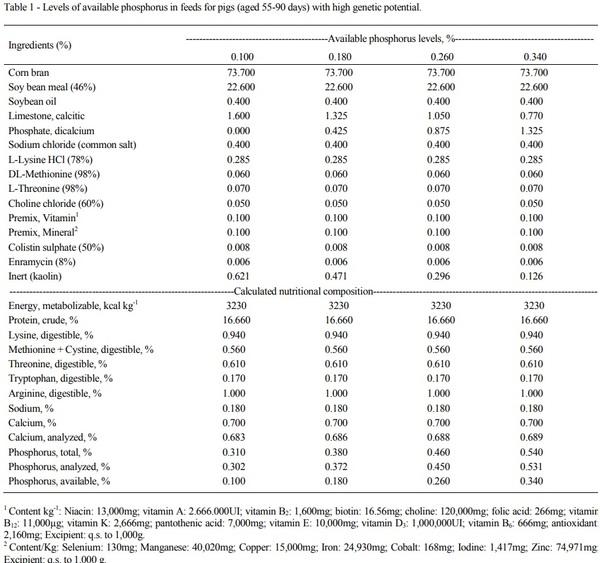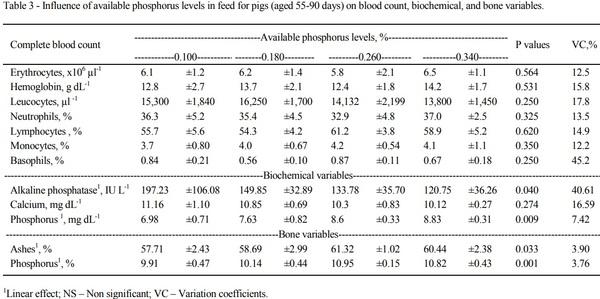INTRODUCTION
Phosphorus is an essential mineral for the formation and maintenance of bone structure, playing additionally a number of functions in the body. According to UNDERWOOD & SUTTLE (1999), phosphorus is found in a high concentration in bone tissue where together with calcium they form hydroxyapatite, which is the major constituent of the skeleton. Phosphorus portion not related to the structural function in the body is contained in high-value organic molecules, such as DNA, RNA, ATP, phospholipids, and phosphorylated proteins.
According to CORREA et al. (2006), genetically improved pigs have as their main characteristics high performance and carcass yield, mainly provided by a high rate of protein deposition. Hittmeieret al. (2006) reported that when phosphorus consumption is low, low genetic potential animals prioritize phosphorus deposition in their bones to the detriment of muscle deposition whereas animals with high genetic potential prioritize phosphorus deposition in their muscles for general development. Thus, knowledge of nutritional needs of this mineral helps nutritionists formulate diets for optimal performance with minimal excretion in the environment.
Effects of genetic breeding and other factors such as ambient temperature, physiological state, and age on phosphorus requirement for growing pigs are well understood among nutritionists. However, few studies in the literature correlate phosphorus need for optimal growth and their effects on the hematological and biochemical parameters in pigs.
Therefore, the purpose of this study was to assess the levels of available phosphorus (AP) in diets for pigs with high genetic potential aged 55-90 days on the hematological, biochemical, and bone performance parameters.
MATERIALS AND METHODS
A total of 64 hybrid pigs (32 castrated males and 32 females, genetic lineage Agroceres PIC®; mean initial weight: 23.31±2.4kg; age: 55-90 days) were used. Pigs were housed in individual pens (1.90x2.90m, 5.51m2, concrete floor; asbestos roof; roof height: 2.50m) provided with precast concrete troughs and pacifier-type drinkers.
The animals were distributed into a randomized block design with four treatments, eight replicates, and two animals (one male and one female) per experimental unit. The experimental diets (Table 1) included corn, soy bean meal, and were supplemented with industrial amino acids to meet the nutritional requirements of growing pigs (ROSTAGNO et al., 2011), except available phosphorus. Treatments consisted of a basal diet and another three diets, which were obtained by supplementing the basal diet with dicalcium phosphate replacing inert phosphate, resulting in four diets with 0.100, 0.180, 0.260, and 0.340% of available phosphorus.
Animals were fed ad libitum with water and with experimental diets. Diets, remained and waste were weighed weekly to determine the feed intake during the experimental period. The animals were weighed at the beginning and end (35 days) of the study to determine the daily weight gain and feed conversion.
On the last day of the experiment, blood samples (six animals per treatment) were collected for analysis of the hematological and biochemical parameters. Samples were collected by puncturing (syringe: 5.0mL, needle 25 x 8mm) of the cephalic vein and stored in sterile tubes. The samples were stored in tubes without anticoagulant for biochemical analysis or with anticoagulant (sodium ethylenediaminetetraacetate, EDTA, 1mg ml-1 blood) for hematological analysis.
Samples stored in tubes without anticoagulant for biochemical analysis were centrifuged (1000rpm, 15min) to obtain blood serum. The determinations of calcium (Ca), phosphorus (P), alkaline phosphatase (AP) concentrations in serum were performed using a semiautomatic biochemical analyzer (BIO 200 F; Bioplus; Vila Velha, ES, Brazil).
In order to obtain the hematological variables of erythrocytes (red blood cell count) and hemoglobin, an automatic electronic analyzer (model SDH 3 VET, Labtest, Vila Velha, ES, Brazil) was used. Leukocytes were counted using a hand counter, and white blood cells (neutrophils, basophils, leukocytes, and lymphocytes) were counted differentially and evaluated by means of blood smear in light microscope (magnification: 1000x) (WEISS & WARDROP, 2010).
At the end of the experimental period, five animals per treatment were slaughtered (close to the average weight; after 12-h fasting) for collection of the right paw. Animals were humanly slaughtered with high-voltage (450V) and low-amperage (0.5A) electric shock desensitization behind their ears (temporal fossae). They were then bled (within 30s) by section of the large vessels or direct puncture of the heart.
After the paws were collected, they were boiled in water (aluminum pan; 25min) to soften the skin and flesh surrounding bones and remove the third metacarpal bone. The metacarpal bone of each animal was kept in a ventilated oven (65°C, 72h) and subjected to breakage. After the bones were broken, they were defatted (Soxhlet extractor) dried in a ventilated oven (105°C; 24h), and triturated in a ball mill. Bone ash contents (BA) and phosphorus (P) in the bones were determined according literature of SILVA & QUEIROZ (2002).

Statistical analysis was performed using the procedures for variance and regression analysis in the System for Statistical and Genetic Analysis (SAEG, for Sistema para Análises Estatísticas e Genéticas, v. 8.0, UFV, 2000; Viçosa, MG, Brazil). Performance characteristics, bone parameters, and biochemical and hematological analyses were interpreted using variance analysis (5% probability). The levels of available phosphorus were estimated using linear or quadratic regression, according to data best fit for each variable.
RESULTS AND DISCUSSION
A quadratic effect (P< 0.01) of available phosphorus levels on the daily weight gain (DWG) of animals was observed (Table 2), increasing the level of available phosphorus up to 0.331%. This corresponds to the consumption of 5.73g d-1 of available phosphorus, according to the equation Ŷ=-5.8644x2 +3.8794x+0.16891 (R2=0.98). This result is different from that obtained by SARAIVA et al. (2011), who assessed the requirement of available phosphorus in female commercial pigs (Agroceres-Pic; 30-60kg) and reported a requirement of 0.372%. AROUCA et al. (2009) used commercial hybrid castrated male pigs (AgroceresPic) genetically selected for a high percentage of lean meat reported a requirement of 0.420% for aP. EKPE et al. (2002) used commercial hybrid male and female pigs (23-60kg) with high genetic potential for meat deposition and estimated a level of 0.330% for better DWG.

Feed conversion was influenced in a quadratic form (P< 0.01) by the treatments (Table 2). It improved the estimated level of 0.302% available phosphorus, corresponding to the estimated consumption of 5.18g d-1 available phosphorus, according to the equation Ŷ=11.966x2 -7.251x+3.237 (R2=0.98). For a better feed conversion, SARAIVA et al. (2009) and AROUCA et al. (2009) recommended a daily intake of 7.36 e 9.11g of phosphorus available, respectively.
The experiments by AROUCA et al. (2009) and SARAIVA et al. (2011) with pigs (30-60kg) are taken as reference, requirements of available phosphorus for gain weight are respectively 11.0 and 21.2% higher than those reported in the present study. These differences between studies may be related to differences between genetic potential, physiological state, age, and growth rate (EKPE et al., 2002). Furthermore, phosphorus requirement can be changed by other factors such as immune system activation. According to KEGLEY et al. (2001), phosphorus requirement for optimal immune response may be greater than that required for maximum growth, since stressing agents can change phosphorus metabolism.
The daily feed intake (DFI), which increased to the level of 0.330%, showed a quadratic effect (P< 0.05) as a function of available phosphorus levels (Table 2), corresponding to the estimated consumption of 5.71g d-1 of available phosphorus according to the equation Ŷ=-7.8620x2+5.1946x+0.8763 (R2=0.98). Alebrante et al. (2011) studied commercial hybrid male and female pigs (15-30kg) and reported a quadratic variation in feed intake as a function of available phosphorus levels (0.107-0.642%) in the diet. Similarly, AROUCA et al. (2009) observed a quadratic effect of available phosphorus levels on the feed intake, which increased to 0.430%. SARAIVA et al. (2009) evaluated the available phosphorus levels in feed fed to pigs with high genetic potential (30- 60kg) observed no effect on feed intake.
In the present study, it can be observed that levels of available phosphorus lower than 0.330% affected the voluntary feed intake. According to BÜNZEN et al. (2012), variation in the consumption due to increase in phosphorus levels indicates that pigs are sensitive to inadequate levels of dietary phosphorus since deficiency or excess negatively affects feed consumption. Regarding intake of available phosphorus (aPI), a positive linear effect (P< 0.01) of the treatments was observed on this variable, according to the equation Ŷ=-0.612522+19.1723x (R2=0.98) (Table 2).
The variation in the available phosphorus levels (0.100-0.340%) in the treatments was not sufficient (P> 0.05) to change the hematological parameters (as measured by hemoglobin determination and erythrocyte and leukocyte counts) and differentiate leukocyte cells (neutrophils, basophils, leukocytes, and lymphocytes) (Table 3). The results obtained in the present study are within the range of reference values reported by WEISS & WARDROP (2010).
According to FRIENDSHIP et al. (1984) the hematological parameters are an important tool to assess animal health. However, they may be influenced by factors as nutritional deficiency, age, and health. Phosphorus is an important element for the phagocytic capacity of polymorphonuclear leukocytes (neutrophils, eosinophils, and basophils) (KIERSZTEJN et al., 1992). Therefore, the correct determination of available phosphorus levels on the basis of hematological parameters is critical for optimal performance of animals. Suboptimal levels may interfere with the production of leukocytes, which are defense cells in the body. Rostagno et al. (2011) recommended the available phosphorus level of 0.322%, which corresponds to an intake of 6.04g d-1 for pigs (castrated male and female animals; 30-50kg) with high genetic potential. The requirement obtained in the present study for the greatest weight gain, without changes in the hematological parameters, was similar to that recommended by ROSTAGNO et al. (2011).

Decreasing and increasing linear effects (P< 0.01) of the alkaline phosphatase (AF) and P values were respectively observed as a function of increase in the levels of available phosphorus in the diets, according to the equations Ŷ=217.921- 306.896x (R2=0.90) and Ŷ=6.28750+7.70833x (R2=0.95) (Table 3). No effect (P> 0.05) of the aP on serum calcium was observed.
Ekpe et al. (2002) assessed phosphorus requirement in growing pigs and reported an inverse relationship between the increase in serum P concentrations and decrease in enzyme activity. Alkaline phosphatase is involved in enzyme processes of bone formation and maintenance, and phosphorus is the second most abundant mineral in the body. According to AROUCA et al. (2009), the phosphorus serum concentration can be used as an indicator of the condition of this mineral in the body. However, correlating serum phosphorus concentration with the values for optimal performance was not possible in this study, since the serum P concentration has not reached a plateau.
The available phosphorus levels influenced (P< 0.01) linearly the increase in the bone ash and phosphorus contents in the metacarpal bone of animals, according to the equations Ŷ=62.2424-1.08232x (R2=0.73) and Ŷ=10.2291+0.075577x (R2=0.81), respectively (Table 3). Similarly, SARAIVA et al. (2009) studied pigs (30-60kg) and observed a linear increase in the content of bone ash and phosphorus in the bones as a function of available phosphorus in diets. Growing pigs prioritize development of muscles and bones (SHIELDS et al., 1983). However, the requirement for maximum bone mineralization is greater than that for maximum gain weight (KETAREN et al., 1993). Our observations are in agreement with the literature, since the aP levels used in this study were not sufficient to maximize these parameters.
CONCLUSION
The available phosphorus levels of 0.331 and 0.302%, corresponding to a daily intake of 5.73 and 5.18g d-1, respectively, provide the best results for weight gain and feed conversion in pigs with high genetic potential. The available phosphorus level of 0.340% in the diet increases serum phosphorus concentration and reduces the alkaline phosphatase activity, but it is not sufficient to meet the requirements for bone deposition.
This article was originally published in Ciência Rural, Santa Maria, v.46, n.6, p.1076-1081, jun, 2016. http://dx.doi.org/10.1590/0103-8478cr20150132. This is an Open Access article distributed under the terms of the Creative Commons Attribution License.











.jpg&w=3840&q=75)